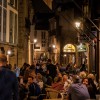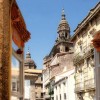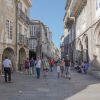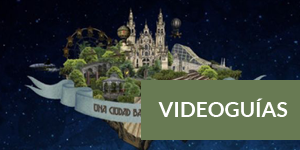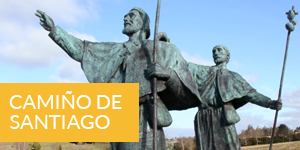- Accede I
- Regístrate I
- carrito
3 días en Santiago
DÍA 1
MAÑANA
Lo primero es recorrer las rúas y plazas del casco histórico para después entrar en la Catedral. Para guiarte en esta tarea, en las oficinas de Turismo de Santiago podes alquilar una audioguía, o apuntarte a una de las visitas guiadas. Se recomienda posponer la entrada a la Catedral para las 12 h. para asistir a la misa del peregrino, en la que, siguiendo un calendario de celebraciones litúrgicas, suele funcionar el botafumeiro. Una vez en la basílica, no puedes perder la oportunidad de visitar el Pórtico de la Gloria o las cubiertas de la Catedral.
COMER
El primer día no podían faltar las típicas raciones gallegas: pulpo “á feira”, empanada, navajas, mejillones, berberechos, o sardinas y “xoubas”, si estamos en temporada, o zorza, lacón, carne “ao caldeiro”, y por supuesto pimientos de Padrón, también en temporada, siempre acompañados de vinos gallegos y detarta de Santiago en el postre. Dónde comer
TARDE
A primera hora de la tarde nos dirigimos a la Cidade da Cultura de Galicia (CdC). No podemos perdernos su magnífica y singular arquitectura, obra del neoyorquino Peter Eisenman. Además, la Cidade da Cultura de Galicia programa interesantes exposiciones temporales y actividades culturales a tener muy en cuenta.
De vuelta en la zona histórica, sugerimos un paseo por los dos principales parques y jardines que ofrecen vistas panorámicas de la zona monumental: San Domingos de Bonaval y la Alameda. El de Bonaval cuenta además con dos interesantes museos. Allí está el principal museo etnográfico de Galicia, el Museo do Pobo Galego, alojado en las salas del antiguo convento de San Domingos de Bonaval, con preciosa iglesia gótica e una fantástica escalera barroca de espiral triple. También en Bonaval está el museo CGAC -Centro Galego de Arte Contemporánea-, notable tanto por su contenido como por el contenedor, diseñado por el arquitecto portugués de renombre internacional Álvaro Siza. Ambos museos tienen en común el parque de San Domingos de Bonaval, que ocupa la que fue finca conventual y proporciona vistas únicas del Santiago histórico.
Antes de cenar, nos dirigimos al céntrico parque da Alameda, el más señorial y querido de la ciudad, y un mirador privilegiado de la zona histórica: desde allí tenemos la mejor foto frontal de la Catedral sobresaliendo en el horizonte.
CENAR
Cocina de autor en alguno de los restaurantes de la exquisita nueva gastronomía gallega. Dónde comer
NOCHE
Para la primera velada, una copa tranquila en alguno de los pubs clásicos compostelanos, por supuesto. Salir de noche
DÍA 2
MAÑANA
El fotogénico Mercado de Abastos es el principal y más tradicional de la ciudad y el lugar más visitado después de la Catedral: un mercado muy auténtico que habla de la gastronomía –hay infinitos pescados y mariscos frescos, pero también frutas, verduras, flores, quesos, etc.- y costumbres de Galicia, en un edificio que es un monumento en sí mismo. Exceptuando los domingos, abre todos los días por la mañana aproximadamente desde las 8.00 hasta las 15.00 horas. Los días grandes, cuando hay mayor cantidad de vendedores y de productos, y también mayor afluencia de público, son los jueves y los sábados. Cerca del Mercado está la Facultad de Geografía e Historia de la más de cinco veces centenaria Universidad de Santiago, con magnífica Biblioteca y Paraninfo, visitables con las Visitas guiadas a la Universidad, al igual que su terraza, con estupenda panorámica cenital de la ciudad histórica.
COMER
En el propio Mercado hay varios establecimientos que no conviene perderse: la 5 es la nave del Mercado de Abastos dedicada a la restauración. En su interior, encontramos varios negocios con barras y mesas centrales con taburetes en las que consumir sus platos. El mejor pulpo lo sirven en la Pulpería Abastos. Casa Millán está especializada en comida tradicional gallega hecha en casa. Taberna Abastos es un japonés con tapas y wok gourmet. Frebas se define como el campo llevado a la cocina y en A Ostrería son expertos en productos del mar. Amoado se caracteriza por su cocina tradicional basada en las filloas con un toque personal. Y en Mariscomanía, por un pequeño porcentaje del precio de la compra, te cocinan al momento los productos adquiridos en el Mercado, para saborear toda su frescura in situ.
Además, en la Rúa das Ameas y la Praza de Santo Agostiño, bajo el cobijo de la actividad del propio mercado, han surgido locales de restauración que lo convierten en un punto de encuentro para compostelanos y turistas: Abastos 2.0, La Radio de Pepe Solla, A Lonxa do Mercado, Lume, O Ghalpón de Abastos, El Hispano, Café de Altamira, Casa Pepe, La Sucursal de Moha, etc.
TARDE
El tren turístico ofrece una visión distinta de la ciudad, además de ser una forma de conocerla muy relajada y apta para todos los públicos, incluidos los más peques. A continuación, para llevar un poco de Santiago y Galicia a casa, hay que ir de compras: artesanía 100% gallega, desde orfebrería, hasta textil artesano o delicatessen.
Santiago, que destaca por la calidad de la rehabilitación llevada a cabo en la ciudad histórica, cuenta con una serie de espacios históricos inéditos, que combinan la solidez del omnipresente granito con acertadas dosis de sofisticado nuevo diseño. Para conocerlos, disfrutando a su vez de las artes plásticas, merece la pena visitar alguna de las galerías de arte y las sedes de las fundaciones presentes en la zona (Granell, Torrente Ballester, Abanca). Para finalizar este periplo, hay visitar todavía salas de exposiciones en espacios de interés monumental e incluso magníficas iglesias desacralizadas, como es el caso del Pazo de Fonseca o de la Iglesia de la Universidad.
CENAR
Para la segunda noche, directos de las rías gallegas, fresquísimos pescados en caldeirada o “a la gallega”, es decir, con ajada, y mariscos al vapor o a la parrilla, otierna carne a la brasa: chuletón de ternera gallega o churrasco de “porco celta” con chorizos. Pero también podemos decidirnos por una opción más informal: una ruta de tapas, para degustar tanto las de cortesía de toda la vida (“cocodrilos”, orejas, patatas...), como montaditos y pintxos, como las de nueva creación: la llamada cocina en miniatura. Dónde comer
NOCHE
Santiago de Compostela ofrece una sorprendente programación cultural: música clásica, teatro, danza, pop, folk, conciertos de pequeño formato, jam sessions, cabaret, magia, cuentacuentos, etc. Agenda cultural
DÍA 3
MAÑANA
Varias entidades organizan excursiones para conocer Galicia comodamente desde Santiago: Fisterra y Costa da Morte, Rías Baixas, A Coruña, Camino de Santiago...
En coche es posible realizar excursiones a los alrededores para visitar los pazos con jardines históricos, los monasterios escondidos en verdes bosques, y pequeños núcleos fluviales que preservan intacto todo el encanto de los tradicionales pueblos gallegos.
COMER
Con el paladar ya acostumbrado a los sabores gallegos, el tercer día ya podemos atrevernos con una completa mariscada, a base de nécoras, centollos, percebes, ostras, camarones... o “exóticos” manjares como lamprea (sólo en temporada). Dónde comer
CENAR
De despedida, gastronomía española con ingredientes gallegos. La tortilla con patata gallega y huevos camperos tiene aquí un sabor especial, y variantes muy sabrosas cuando se rellena de productos de la tierra –chicharrones, chorizos del país, grelos, etc.-. Aunque mediterráneos, los arroces “galleguizados” admiten con indiscutible éxito, tanto en paella como en otras preparaciones, la aportación de los profundos sabores de Galicia, como es el caso del arroz con bogavante. Dónde comer
LA ÚLTIMA NOCHE
No podemos irnos de Galicia sin conjurar contra las “meigas” y los malos espíritus con una buena queimada, que encontraremos en muchos pubs de la zona histórica. Por supuesto, también son de obligada degustación los aguardientes de Galicia, incluido el archiconocido licor café.
Antes de retirarse, un último paseo noctámbulo por las plazas monumentales, llenas de melancolía a estas horas. El Obradoiro, con su balcón que mira al ocaso, el sonido de los pasos bajo el arco del Pazo de Xelmírez, la Quintana con la sombra del peregrino, la Catedral sobresaliendo en la oscuridad de la noche desde la Alameda, las “trece” campanadas de medianoche... Bienvenidas/os a Compostela! Salir de noche









